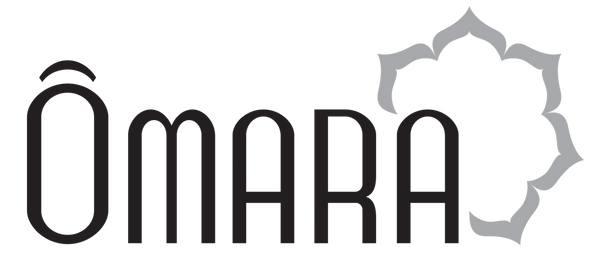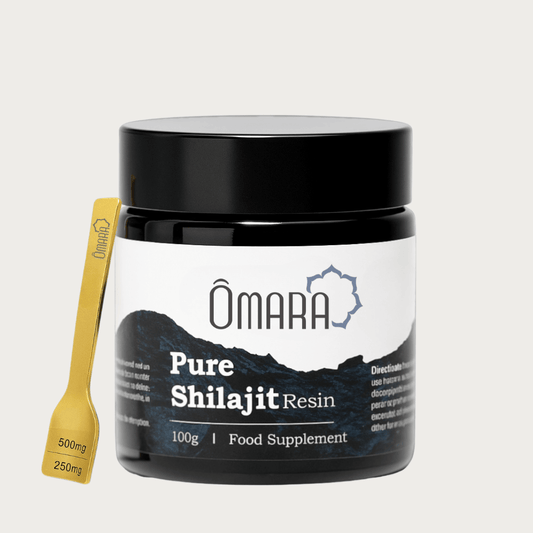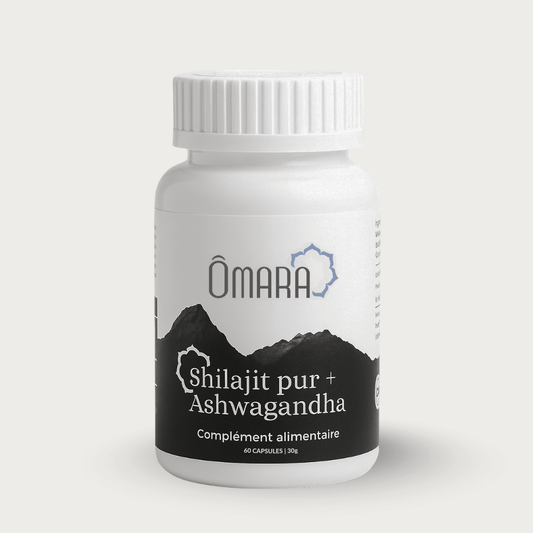
Cordyceps: origins, health and sports benefits, recommended dosage
Share
Cordyceps: The Mushroom of Energy and Endurance
Looking for a natural solution to boost your energy, improve your endurance, or support your immune system? Cordyceps, an adaptogenic mushroom prized for millennia in traditional Chinese medicine, offers promising benefits for vitality and physical performance. Discover its origins, active compounds, science-backed benefits, and our tips for incorporating it into your daily routine.
Cordyceps: The Energy Mushroom
Origins and traditional uses
Cordyceps (usually Cordyceps sinensis , synonym Ophiocordyceps sinensis ) is an entomopathogenic fungus found wild on the Tibetan Plateau and in the Himalayas (Tibet, Nepal, northern India) at very high altitudes. It parasitizes butterfly larvae (family Cordycipitaceae), hence its nickname "mountain worm" or "caterpillar". At altitudes over 3,000 m, this fungus has evolved to withstand extreme conditions.
For over 3,000 years, Tibetan legends have told of yak herders noticing their increased vigor after grazing on hills where cordyceps grew. In Traditional Chinese Medicine (TCM), it was considered a general tonic: it was reserved for the sovereign and a few elites (emperors, Dalai Lamas) to strengthen vital energy, respiratory, and kidney functions. Cordyceps gained worldwide fame when Chinese athletes broke several running records in 1993, attributing their exceptional performance to a cure that included this mushroom. This story popularized Cordyceps as an endurance and energy booster.
Composition and active ingredients
Cordyceps is renowned for its richness in bioactive compounds. The most studied is cordycepin (3′-deoxyadenosine), a nucleoside with powerful pharmacological properties. Cordycepin has antimicrobial and antioxidant properties and promotes the production of ATP (adenosine triphosphate), a key molecule in cellular energy. In addition, cordyceps contains numerous immunostimulatory polysaccharides , as well as proteins, essential amino acids, vitamins (B1, B2, B12, E, K) and minerals (copper, iron, magnesium, selenium, zinc, manganese, etc.). These elements give it antioxidant (particularly via vitamin E and phytosterols) and immunomodulatory properties. In summary, cordycepin, polysaccharides and micronutrients make Cordyceps a potentially tonic “superfood”, although the mechanisms of action remain partly to be elucidated.
Cordyceps sinensis vs. Cordyceps militaris: what’s the difference?
Two species of Cordyceps are used as supplements: Cordyceps sinensis , from the wild Himalayan mushroom, and Cordyceps militaris , which is easier to cultivate industrially. The table below compares their key characteristics:
| Species | Origin / Culture | Cordycepin | Remarks |
|---|---|---|---|
| Cordyceps sinensis | Wild, Tibetan plateau (Himalayas) | Low (naturally present) | Rare and expensive (“brown gold of the Himalayas”). |
| Cordyceps militaris | Industrially grown on substrates (no caterpillars) | Very high (up to 90× more than sinensis ) | Modern sources of supplements: sustainable, high concentration of active ingredients. |
Cordyceps militaris has become the major modern alternative: it is easily cultivated in the laboratory without the need for an insect host, thus avoiding the rarity of wild sinensis . In addition, C. militaris contains much more cordycepin – up to 90 times more than the original Cordyceps sinensis . For this reason, the majority of dietary supplements today use C. militaris , while retaining the name "cordyceps." In this guide, we will refer to both sources ( sinensis or militaris ) interchangeably as Cordyceps, which are considered to have similar effects.
Health benefits
Cordyceps is classified as an adaptogen : it helps the body adapt to stress and strengthen its overall balance. Here are its main proposed benefits, based on tradition and certain studies:
- Reduced energy and fatigue : Cordycepin stimulates the production of ATP (cellular energy), resulting in increased vitality. Cordyceps supplements are traditionally prescribed to fatigued individuals or those convalescing from illness to support their energy reserves.
- Endurance and performance : Many sources indicate that cordyceps improves physical endurance by optimizing oxygen utilization. For example, an increase in VO₂max (maximal oxygen uptake) is often reported after Cordyceps treatment. Recreational athletes have reported improved aerobic capacity after several weeks of supplementation. Cordyceps may also reduce muscle recovery time after exercise, thanks to its anti-fatigue and anti-inflammatory effects.
- Immune and respiratory support : In TCM, cordyceps is known to "tone" natural defenses and support the lungs (useful at altitude or in harsh climates). Its richness in polysaccharides and antioxidants makes it a potential immunostimulant. In practice, some users report fewer infections or faster recovery in winter during a cordyceps treatment.
- Antioxidant protection : Cordycepin, vitamin E, and minerals provide antioxidants that protect cells from oxidative stress. This "anti-aging" role of Cordyceps (limiting free radical damage) is traditionally touted, even though official health authorities do not formally authorize the "anti-aging" claim.
In addition to these effects, animal studies suggest benefits for liver and kidney health, as well as a moderate bronchodilator effect (useful for asthma). Cordyceps was traditionally called "yak god mushroom" for its all-encompassing benefits. It's important to note that despite these potential benefits, most are based on tradition or preliminary studies. Clinical research remains limited. Nevertheless, Cordyceps remains highly sought after as a natural supplement for boosting vitality.
Cordyceps and sports performance
Athletes are particularly fond of Cordyceps, in search of a natural supplement to improve endurance. Some clinical studies have explored this avenue. For example, in about twenty volunteers aged 50-75, 12 weeks of supplementation with Cs-4® (fermented Cordyceps sinensis , 3 × 333 mg/day) increased the metabolic threshold (VO₂θ) by 10.5% and the ventilatory threshold by 8.5%, a sign of better exercise tolerance. On the other hand, VO₂max did not change in this small trial, which suggests an effect on anaerobic capacity more than on maximal oxygen consumption. Conversely, a more recent study showed that after 1 week of taking a 4 g/day mixture of Cordyceps militaris , the improvements measured in exercise load were minimal. According to the authors, more clear benefits could appear during longer treatments (≥ 3 weeks).
In detail, the results are mixed: some studies report an improvement in aerobic performance (VO₂max) after several weeks of use, while others do not find a notable gain in VO₂max over short periods (5-6 weeks) even with 3 g/day. The main effect seems to be on lactate and ventilatory thresholds (reducing fatigue) more than on maximum power. In summary, Cordyceps could "push the inner coach" by improving resistance to fatigue and muscle recovery, but it is not a substitute for training and research recommends longer trials to confirm these effects. In any case, its energy and adaptogenic profile make it an interesting ally for endurance athletes.
Directions for use and dosage
Cordyceps is primarily consumed as a dietary supplement. Here are the most common forms:
- Dry powder : This is the traditional form (dried fruit) used to prepare decoctions or infusions. It can also be incorporated into smoothies, soups, or hot drinks, without altering the flavor of the food. The raw powder is convenient for adjusting the dose as desired.
- Capsules (powder or dry extract) : This is the most common form today, for precise and tasteless dosing. Capsules contain either whole powder or extracts concentrated in active ingredients. Their advantage is convenience (no preparation) and consistency of dosage.
- Liquid extract : available in ampoules or dropper bottles, it is a concentrate of the active ingredients (by aqueous or hydroalcoholic extract). This form allows for rapid delivery and high bioavailability, dosed by dropper in a drink. It is not linked to cooking, which preserves all the soluble compounds.
The dosage depends on the form (powder vs. extract) and concentration of the product. According to Health Canada recommendations, dry powder should not exceed 3 g per day and decoctions (unconcentrated water) 9 g of dried cordyceps per day. Tibetan tradition, on the other hand, suggests higher doses (5-10 g/day of powder). In practice, 1 to 3 g per day of pure powder or standardized capsules is often recommended. A course of treatment generally lasts 4 to 12 weeks, followed by a break (1 month) before repeating it.
In all cases, respect the recommended doses and start with small quantities if you have never taken cordyceps (to test tolerance). The mushroom is well tolerated, but it can cause mild digestive problems (nausea, diarrhea) or allergic reactions (hives, itching) in some people. It is therefore prudent to consult a health professional before starting a treatment, particularly in cases of pregnancy, mushroom allergy or medical treatment.
Organic Cordyceps: quality and safety
As with any mushroom supplement, it is strongly recommended to choose a certified organic cordyceps. Indeed, mushrooms filter the environment and can concentrate heavy metals, pesticides or other contaminants. A product from organic farming guarantees the absence of unwanted chemical residues. In addition, the quality of drying is crucial: drying at low temperatures preserves the nutrients and active compounds of the cordyceps. Therefore, favor brands that are transparent about their traceability, with analyses guaranteeing purity and titration of active ingredients (cordycepin, adenosine, polysaccharides). Finally, check that the manufacturer clearly indicates the species used ( sinensis or militaris ) and the form (whole powder vs. concentrated extract).
Clinical research and scientific studies
The scientific literature on Cordyceps is slowly growing. Clinical trials are still few in number and often small in scale. Among them:
- A double-blind study showed that a standardized preparation of Cordyceps sinensis ( Cs-4® ) at 3 g/day (divided into 3 doses) for 12 weeks significantly increased the metabolic threshold and ventilatory threshold in subjects aged 50–75 years, without changing VO₂max. The authors concluded that prolonged Cordyceps intake could improve aerobic performance beyond usual exercise.
- In contrast, a recent study of young adults (2016) observed that after 1 week of supplementation with 4 g/day of Cordyceps militaris (mixed with other mushrooms), gains in aerobic and anaerobic performance were minimal. This study suggests that the benefits only appear over longer courses, or that the dose/duration used was not sufficient to see an effect.
- Three clinical trials conducted in China (1995–1999) in elderly patients reported a significant improvement in daily physical capacities after cordyceps supplementation, confirming its “tonifying” properties. In addition, systematic reviews and meta-analyses (mainly published in China) suggest that cordyceps may protect the liver and kidneys (e.g., against drug-induced damage) and may decrease inflammatory parameters.
Despite these encouraging results, Western health authorities have not validated any specific health claims for cordyceps (no formal "health" claim is approved by the EFSA in Europe). In other words, Cordyceps is considered a natural tonic supplement, not a drug. Ongoing studies are aimed at clarifying its exact role and the best conditions for use (species, dose, duration). For now, it can be noted that Cordyceps is generally safe and potentially beneficial, but it is not a substitute for targeted training or medical treatment in the event of a health problem.
Conclusion and practical advice
Cordyceps is a promising natural supplement for anyone looking for a boost of energy and improved endurance, whether they're athletic or simply tired. To reap its benefits while minimizing the risks, here are some tips:
- Choose a certified organic cordyceps . An organic mushroom guarantees the absence of pesticides and heavy metals.
- Start with small doses . Follow the recommended dosages (≲ 3 g/day of pure powder) and increase gradually.
- Reasonable duration of treatment . A course of treatment of 1 to 3 months (ideally 2 months) is generally sufficient, followed by a break of at least 4 weeks.
- Convenient form . Organic Cordyceps capsules offer easy daily dosing, while the powder can be added to your drinks.
- Patience and balance . Don't think of Cordyceps as an overnight miracle. It's part of a healthy diet and an active lifestyle. Results can take several weeks. You might want to combine it with a varied diet and proper training to get the most out of it.
In conclusion, Cordyceps (in organic supplement form, powder or capsules) can be a natural aid to energize the body. Athletes will appreciate its potential to support endurance, stressed or tired people its tonic effect on fatigue, and everyone its antioxidant properties. Before any treatment, inform yourself and, if in doubt, consult a healthcare professional.
Boost your energy today! Discover our Organic Cordyceps capsules, formulated to combine convenience and high quality. Enjoy its benefits to revitalize your daily life.
Save 20% with code VITALITE on your Organic Cordyceps now (only available on the next 5 orders)


